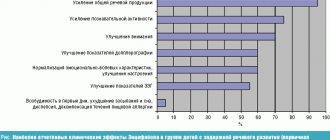The birth of a child is not only a great happiness, but also a great responsibility for parents. After all, it depends on mom and dad how developed their baby will grow physically, mentally and emotionally. The job of parents is not to just stand on the sidelines and watch their child grow. They need to try to help the baby grow into a well-rounded personality. In our article we will look at what the harmonious development of children is. We will definitely dwell on the methods and principles of education, talk about the need to create conditions for the comprehensive development of the child, and present tips and recommendations from psychologists.
What is the harmonious development of a child’s personality?
Raising children is a complex and responsible process. And the main goal, the so-called ideal, is the “creation” of a harmoniously developed personality. It’s just impossible to choose a single template that will suit a particular child, since each person, starting from the moment of his birth, is an individual.
The harmonious development of a child’s personality as a goal involves raising a comprehensively developed person: physically, psychologically, intellectually. All these sides are equally important and complement each other in every possible way. It is impossible to achieve harmony as a whole if you do not pay enough attention to each component:
- Physical development involves the development of the body. A healthy, strong and resilient person will easily perceive different energy flows.
- Psychological development affects the emotional sphere, the soul. Starting from childhood, a person learns to master art, appreciate beauty, etc.
- Intellectual development. During his life, a person must understand the world and himself. The task of mom and dad is to help the child realize his mental abilities to the maximum.
Parents must combine all three components together and create all the necessary conditions for the comprehensive development of their child.
Section 1. Prerequisites for physical intelligence
Physical, mental and social development is one of the most important gifts from nature to man.
Any child who has the opportunity to achieve physical perfection will be incredibly happy to take advantage of it.
At the moment of birth, children are at their maximum mental potential, and learning for young children is one of the basic skills required for survival.
Young children want to learn everything they can, as quickly as possible. In addition, they are confident that there is nothing better than learning in the world.
The younger the child, the more pleasure he gets from the learning process, and the easier it is for him. And the older a person gets, the less he believes that learning is a joy. Adults often perceive learning as torture.
When to start raising a child?
Infancy is the first step on the path to harmonious development. Children absorb all information like a sponge, so education and development of their intellectual abilities should be done from birth - at three or five years old it may be too late. Scientists studying human potential have concluded that 1.5-2 years is the optimal age to teach a child to read.
The generally accepted methods used today are not aimed at the harmonious development of the individual, but at raising a person convenient for society. They are based on literally driving knowledge into a child’s head, making him obedient to parents, polite to teachers, etc. At the same time, parents who want their baby to grow up harmoniously developed should not put much hope in kindergartens and schools . It is necessary not to assign the responsibility for education to government agencies, but to do it independently. But the main thing is that you need to do this with love for your child.
About Glenn Doman
Glenn Doman is an American physical therapist, the developer of a series of rehabilitation techniques for children with lesions of the nervous system, and a method of training children (the Doman method).
In addition, Doman founded the Institute for the Development of Human Potential and organized the publishing house “Gentle Revolutıon,” which advises parents on education issues. Glenn and his colleagues' mission is to teach every parent how to raise a charming, talented, and intelligent child, thereby creating a highly humane, healthy, and decent society. You can get more detailed information about the author and his methodology on the websites “Gentlerevolution.com” and “Iahp.org”.
General principles of harmonious development
When raising children, you should adhere to the following principles:
- There is no need to instill in your child the idea that adults are smarter than children just because they are older than them.
- Not to teach children, but to stimulate their interest in learning so that they can learn it themselves.
- Do not force children to do anything without their desire, try not to use coercive measures against them, except in cases where this cannot be avoided.
- Adults should take into account the child’s choice and agree with it only if it (the choice) is not capable of harming their health.
- The process of gaining knowledge is more important than the result.
For the all-round harmonious development of a child, it is important to devote enough time to the education of the soul. This concept includes the practice of art, communication with nature, knowledge of the laws of nature and the laws by which people live, the ability to love oneself and loved ones. In this regard, you should not rely too much on educational institutions. The best education and development for a child can be given by his loving parents.
Child growth standards and reasons for its decline
Before talking about pathology, it is necessary to determine the normal physiological growth increases.
For children under one year old and for older children, there are different criteria for growth norms - monthly increases and determination of the normal growth rate using centile tables.
Monthly growth increases in children of the first year of life
Features of growth increase in the first year of life for full-term children:
- On average, the baby gains 3 cm over a monthly period.
- The total increase in the first year of life should be at least 25 cm. Thus, the normal figure for a one-year-old baby is from 74 to 76 cm.
- Children grow more rapidly in the first months after birth, after which this process slows down.
Months of life:
1-3 months – 3-3.5 cm monthly;
4-6 months – 2.5 – 3 cm;
7-9 months – 1.5 cm;
10 – 12 months – 1 cm.
The child's height, as well as his weight (for children in the first three years of life + head circumference) should be measured annually.
Parents should monitor this, because in the event of any deviations from the norm and/or the appearance of various symptoms indicating the development of diseases, including endocrine ones, these indicators will be of great importance for the timely diagnosis of the disease, further observation and the effectiveness of the prescribed treatment.
As an endocrinologist in my practice, I often encounter retardation in height and weight, and the lack of annual height and weight indicators significantly complicates a preliminary diagnosis - from constitutional growth retardation to a decrease in physiological annual growth in somatic pathology and true endocrine pathology.
It is important to know not only how much the child is stunted in growth, but also when and for what reason these changes occurred - from birth or after a certain period of time.
Centile tables
After one year, height is correctly determined using centile tables that determine the child’s growth levels.
To determine the approximate correspondence of height and weight to age, different formulas are found on different sites; they are more for parents and are indicative in nature. You should be aware that they have significant errors, do not take into account the gender of the child and indicate average height and weight values.
Centile tables were compiled based on WHO studies that were conducted in the period 1997-2003. and in which the growth standards for children are read depend, first of all, on the gender of the child, therefore, for girls and boys, WHO has created separate tables with average indicators.
Depending on the age of the baby, the ratio of body length and weight, as well as growth, will also differ. In addition, using centile tables, you can determine growth levels and their annual changes, you can build a growth curve and determine its degree of deviation from the average values, and in case of short stature - dynamics of change before and after treatment.
Growth levels according to centile tables:
- less than 3% – very short stature (short stature) – the child must be examined by an endocrinologist;
- from 3% to 10% – short stature – requires observation, if additional symptoms are present, examination is necessary;
- from 10% to 25% – growth below average (variant of the norm, observation by a pediatrician);
- from 25% to 75% – average growth;
- from 90% to 97% – high growth – observation by a pediatrician, normal variant; more than 97% – very tall (tall) – observation and examination by an endocrinologist.
The same indicators from paracentile tables are used to estimate a child’s weight.
The harmony or disharmony of physical development in children is assessed by body mass index (BMI) - weight/height squared. Today there are many convenient calculators for calculating BMI.
- Development is harmonious - when the child is classified from the 10th to 90th centile corridor according to BMI;
- disharmonious – from the 3rd to the 10th and from the 90th to the 97th centile corridor according to BMI
It is also necessary to determine the proportionality index:
Weight-height coefficient (in full-term newborns at birth)
Weight/Height× 100% normal
= 60 – 65%;
I degree of intrauterine growth retardation
– 59-55%;
II degree
– 54- 50%;
III degree
– less than 50%.
It should be borne in mind that these tables are used only for full-term newborns.
Growth - norms and pathology in premature babies
In premature infants, it is necessary to determine the correspondence of physical development to the gestational age. Development corresponds to gestational age when assigning weight, body length, head circumference, weight-height coefficient from the 10th to the 90th percentile.
Intrauterine growth retardation is diagnosed with consistently low indicators with two or more measurements below the 3rd percentile - with height less than 48 cm, weight less than 2200 g.
All children with intrauterine growth retardation must be observed by a pediatric endocrinologist.
After 43 weeks, assessment of physical development is carried out according to charts for young children, but taking into account the corrected age (the difference between the actual postnatal age in weeks and the weeks of gestation missing to full term).
The highest growth rates of premature babies are in the first 3 months of life (3.5-5 cm per month).
- In the first half of the year, the monthly increase in height is 2.5-5.5 cm,
- in the second half of the year - 0.5-3 cm.
The total increase in height per year is 27-38 cm. The average height of a newborn child by year is 70.2-77.5 cm.
The body weight of premature babies in the 1st year increases 6-7 times; an increase of 20 g/kg body weight at birth is adequate. Anthropometric indicators are equal to those of full-term children aged approximately 2 years, but with a body weight of up to 1500 g. indicators are lagging behind.
In any case, if there is a change in growth rates, parents need to pay attention to this, and if there is a persistent deviation, consult a pediatric endocrinologist.
Main causes of stunting
Most often, stunting is caused by the constitutional characteristics of the child’s growth and development.
Highlight:
- Constitutional delay in growth and puberty (late puberty syndrome).
- Familial short stature.
- Congenital somatotropic deficiency - isolated or with multiple hormone deficiency).
- Acquired somatotropic insufficiency.
- Laron syndrome occurs when the sensitivity of receptors to growth hormone is impaired.
- Hypothyroidism (thyroid hormone deficiency).
- Short stature due to genetic diseases (Shereshevsky-Turner, Nonne syndrome).
- Pseudohypoparathyroidism (Albright's syndrome).
- Somatically caused growth disorders - congenital and acquired chronic diseases (heart, kidney, liver, blood, intestines, metabolic disorders, pathology of the skeletal system).
Other causes of stunting
Many factors can have a negative impact on the processes of growth and development. The main ones are genetic and environmental changes that can affect the fetus even in the prenatal period.
Environmental factors
Damaging exogenous (external) factors during the period of intrauterine development can be chemicals, including many drugs, ionizing radiation (for example, X-ray in diagnostic doses), hypoxia, fasting, drugs, nicotine, viruses, etc.
Chemicals and drugs that penetrate the placental barrier are especially dangerous for the fetus in the first 3 months of pregnancy, as they accumulate in elevated concentrations in the tissues and organs of the fetus.
Drugs impair brain development. Starvation and viruses cause malformations and even intrauterine death.
Chronic diseases, as well as medications, can affect the growth processes and maturation of the fetus and, subsequently, the child.
Therefore, it is extremely important to protect the future baby from their harmful effects:
- eat rationally, while eliminating all foods that can have a negative effect (allergens, fats, preservatives, food additives, a lot of sugar);
- minimize the use of medications;
- monitor your health so that you can respond in a timely manner to the development or exacerbation of diseases;
- reduce active motor and emotional stress.
Genetic factors
It is very difficult to recognize the role of genetic factors and yet they can be foreseen - the genetic basis of growth hormone deficiency in the presence of first-degree relatives with the same pathology in 5-30% of cases.
This is due to various mutations in the PIT-1, PROP1 (prophet of Pit1), GH1 genes, which regulate the development of the pituitary gland during embryonic development. Today, they have a recessive inheritance pattern (i.e.
An important factor must not be present in both parents - consanguineous marriages or people living for a long time in the same territory - short stature is considered an ethnic feature of some peoples.
In this situation, if close relatives have growth hormone deficiency, isolated or in combination with other manifestations of disorders of the hypothalamic-pituitary region, children suffering from growth disorders, it is possible to conduct a molecular genetic examination of the parents and determine the risks of developing growth hormone secretion in the child and related health problems in the future.
Manifestations of growth retardation and the formation of congenital forms of short stature are noticeable already in the first 3-6 months of life, if this is combined with a burdened family history (the presence of first-degree relatives with the same pathology with short stature) or a closely related marriage - the baby must be examined by a pediatric endocrinologist.
Stunted growth of a child in the first years of life may be associated with exposure of the fetus to negative external or internal agents:
- difficult pregnancy;
- taking medications;
- taking alcohol or drugs, smoking;
- frequent stress during pregnancy.
These children should also be observed by a pediatric endocrinologist.
External factors after birth
The most common cause of somatotropic insufficiency is tumors of the central nervous system of various etiologies, primarily affecting the hypothalamic-pituitary region. After treatment of such tumors (surgery, radiation therapy, chemotherapy), as a rule, manifestations of hypopituitarism (somatotropic insufficiency) increase.
Injuries are also possible, including birth injuries with asphyxia and fetal distress - difficult childbirth, aids used (obstetric Spitz, vacuum fetal extraction), rapid birth.
Significant reductions in growth rates are observed after treatment of tumors that do not affect the hypothalamic-pituitary region - irradiation of the head and neck for leukemia, medulloblastoma, retinoblastoma, lymphogranulomatosis. A decrease in growth hormone production is observed after chemotherapy.
A number of space-occupying formations that are anatomically unrelated to the pituitary gland may be accompanied by a decrease in the production of growth hormone - optic nerve glioma, astrocytoma, localized in close proximity to the hypothalamic-pituitary region.
pediatrician, pediatric endocrinologist Olga Ivanovna Sazonova
Source: https://zen.yandex.ru/media/mirmam/normy-rosta-rebenka-i-prichiny-ego-snijeniia-5dbd2883e3062c00b16a00a3
Education methods
In the process of harmonious development of children, the following methods of education are used:
- Suggestion. The method involves influencing the child’s emotions, feelings, and through them his will and mind. As a result of suggestion or self-hypnosis, a person begins to worry about his actions and analyze them.
- Belief. This method is based on logical conclusions made by the child. Belief contributes to the formation of views or concepts. To implement the method, fables, excerpts from literary works, and historical analogies are used.
- Exercise. The purpose of this method is the formation of skills and habits as a result of repeated repetition of similar actions, bringing them to automatism.
- Encouragement. The method is a positive assessment of the child’s actions. This is approval, praise, gratitude, reward. Encouragement builds self-confidence and self-confidence.
When choosing one or another method of education, it is important to take into account the age of the child, his age and personality characteristics.
Physical development of children
Harmony represents the development of all aspects of human activity. Both body and soul must develop equally. If parents want their baby to be healthy, smart and cheerful, in the process of raising him, they must pay attention to his harmonious physical development.
A child who receives feasible physical activity increases his functional capabilities. He learns to rationally use his internal energy reserves and achieve much more than his peers. Simultaneously with physical activity, the development of intelligence occurs. It is not at all necessary (although this will only be beneficial) to send your child to sports clubs. It is enough to replace them with daily exercises and active walks (with a bicycle, scooter, roller skates, etc.).
What is needed for the comprehensive development of a 1 year old child?
A baby who is not yet 12 months old already has enormous potential for development. Therefore, the task of parents is to use it to the fullest. And for this they should follow some rules:
- Create a developing atmosphere for the child. We are talking not only about expensive and functional toys, but also about joint walks with the study of everything that surrounds the baby: trees, insects, etc.
- Carry a child in your arms. In close proximity to the mother, the baby feels safe, which means he grows up more psychologically stable and calm.
- Talk a lot with your child. For the harmonious development of children in the family, it is important to form in the child a positive attitude towards the world from birth. At first this happens through affectionate addresses to the baby, and a little later through funny songs, nursery rhymes and jokes.
- Do not compare your child with other children. Each baby has its own innate abilities, so you should not try to surpass someone in development and demand unbearable results.
Preface
The motor development of a child at an early stage is the most important component of his preparation in the future not only for cognitive activity, but also for the development of a huge number of other possibilities. Glenn Doman methodically reveals all stages of mobility development and devotes particular attention to organizing the environment in such a way that it maximizes the development of the child. By following precise and clear instructions, parents will be able to create an individual home development program.
Working with different children, the author and his assistants made a stunning discovery - the speed of a child’s physical development affects the speed of his brain development. This means that a child’s intelligence depends on how well he is physically developed.
Conditions for the harmonious development of a preschool child
These conditions include:
- Having an adult nearby. We are talking about a loved one, mother, father or grandmother, to whom the child can sit on his lap at any moment, hug him, and share secrets. And those parents who believe that a four-year-old child needs mother’s love and affection less than a baby do are very mistaken.
- The same principles of education in the family. The child will only be able to understand them when all the rules are the same: if they punish, then both mom and dad, etc.
- Child development in play. Over time, the baby should become familiar not only with simple toys, but also with story-based games and role-playing games. And his mom and dad will help him with this.
- Moderate loads. For the harmonious development of preschool children, daily walks, music lessons with learning songs, and exercise are important. But you shouldn’t overload your baby with classes and homework. Everything has its time.
- An example to follow. It is unlikely that a child will eat healthy cauliflower if the parents eat fried potatoes. For a child to grow up healthy and successful, he needs a role model.
- Personal space. A child needs, if not a separate room, then at least his own corner.
Section 2: How to Strengthen Your Child's Physical Intelligence
If a child has the opportunity to crawl as long and as often as possible, he will develop faster, and his brain will also grow faster.
Based on the characteristics of modern culture, a fat child is considered healthy. However, the author is sure that children should not be fat, and mother’s milk should turn into muscle, not fat. In the future, this will contribute to the development of potential and beauty.
In order for a newborn to develop as best as possible, he must be awake for at least 4 hours during knocking, and during this time he needs to crawl on the floor or a special track. It would be best if the child sleeps on such a track.
An interesting technique: even before the child reaches six months of age, until he has learned to walk, you need to lower him head down onto a soft mat, bending his head with one hand and holding his hips with the other, and turn him over. If you perform this exercise 15 times a day, the child’s brain will learn to orient itself in a given direction.
Features of the harmonious development of a teenager
From the age of nine, a child experiences both physical and emotional changes. All feelings and emotions manifest themselves very violently. Teenagers become too irritable and get offended over trifles. You should know that such changes are quite natural for this age.
During adolescence, difficulties may arise in communicating with peers and with parents. During this period, it is important not to put strong pressure on the child (especially by introducing a system of prohibitions), and try to find a common language with him. For the harmonious development of a teenager it is necessary:
- teach him to manage his emotions;
- avoid categoricalness and maximalism;
- think positively;
- provide a balanced diet, sufficient time for sleep and rest;
- control studies;
- monitor compliance with the daily routine.
Despite your workload, try to find time to communicate with your child, walk in the fresh air, relax in nature, exercise and play sports.
Recommendations for education and harmonious development of personality
The following advice from psychologists will be very useful for parents of children of any age:
- Accept the child for who he is.
- Do not consider the child to be his property.
- Love your child, be honest with him and be patient with your baby.
- Don't take parenting too seriously.
- Respect your child.
- Give the child freedom in his development and in choosing what he wants to do.
Using the best modern techniques will be completely useless for the harmonious development of children in the absence of love and understanding on the part of their parents.











